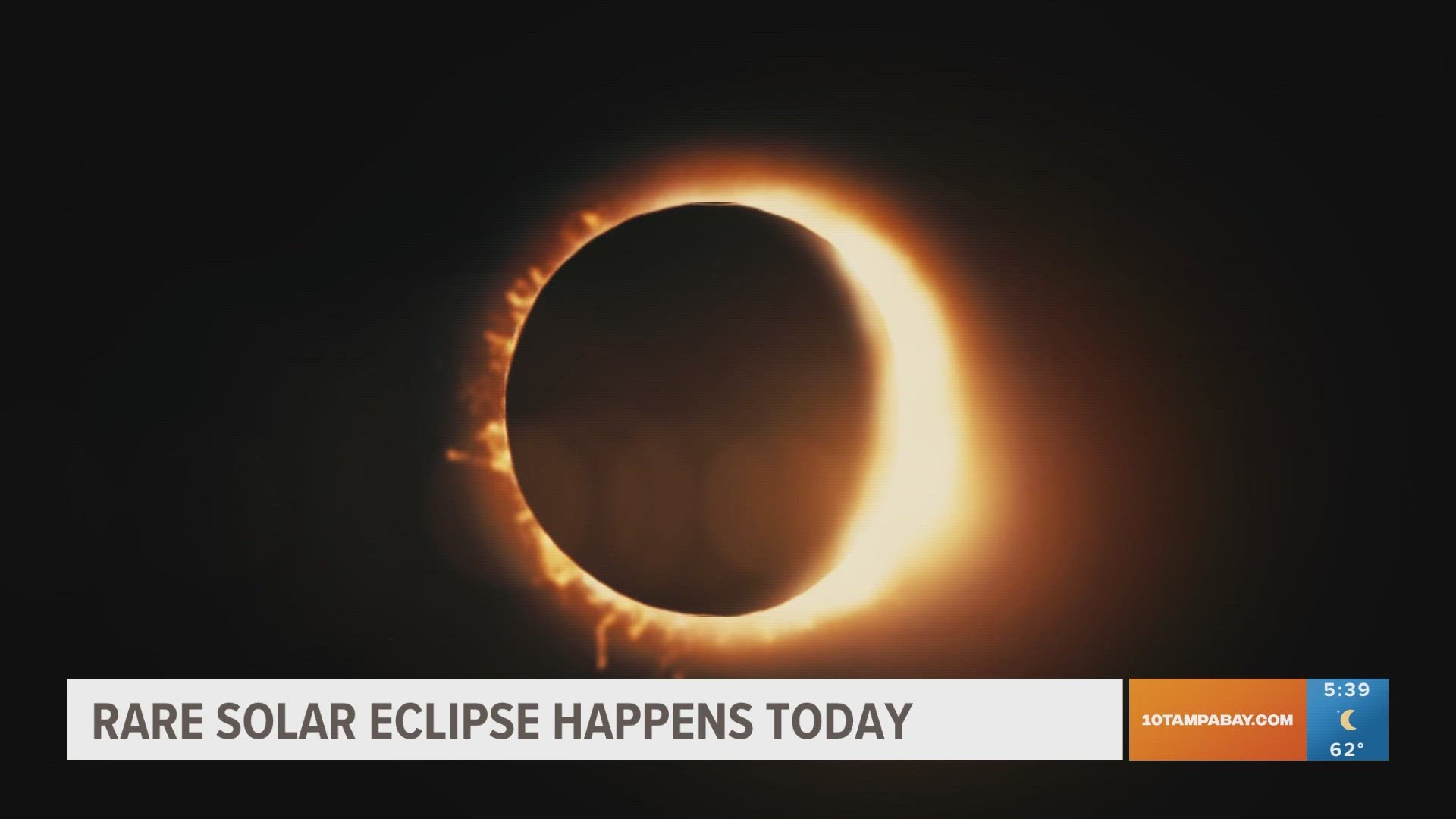TAMPA, Fla. — The day has finally arrived: The 2024 solar eclipse.
Though people in the eclipse's path of totality will see the phenomenon in its entirety in places like Texas, Oklahoma, New York, and Maine, Tampa Bay will see a greater percentage of the action than some Florida cities and most states on the Pacific Coast.
Happening just shortly after 1:30 p.m. to about 4:15 p.m. in the Tampa Bay area, you can pull out your lawn chairs in a big field or on your backyard patio overlooking the warm waters of the Gulf.
Before you stock the coolers and grab your protective eyewear, 10 Tampa Bay is providing you a kaleidoscope of information, from cautionary to scientific, answering all questions you may have before you look up on April 8.
Where you can watch the upcoming solar eclipse in Tampa Bay
While the Tampa Bay area is not in the path of totality for the 2024 total solar eclipse, there still will be a partial eclipse with darkening skies. A few viewing parties are planned for people who want to catch a glimpse.
In Tampa, the eclipse begins at 1:43 p.m. on Monday, April 8, with mid-eclipse happening around 3 p.m. This is about when 65% of the sun will be covered by the moon.
What time you can watch the solar eclipse in Tampa Bay and across the state
The partial eclipse will begin as early as 1:35 p.m. Eastern Time in the Pensacola area, according to Eclipse2024.org. Florida's Panhandle will experience the greatest magnitude of the eclipse because it's closest to the "path of totality."
Mid-eclipse will occur as early as 2:55 p.m. Eastern Time.
Will clouds obstruct our view in Tampa Bay?
We could see a few high clouds filter in by the time the eclipse begins, but overall, we'll be staying rain-free all day so it'll still be worth stepping outside to check out this celestial event.
How to safely watch the solar eclipse in the Tampa Bay area
Our VERIFY team confirmed that the only safe way to look at the sun during a total solar eclipse is by using special glasses or filters. And just a heads up, your regular sunglasses won't cut it.
You'll need eclipse glasses or special-purpose solar viewers.
Here's where to find safe eye protection for Monday's solar eclipse
As the moon passes in front of the sun on Monday, it's important to be prepared to view the rare celestial spectacle safely.
Special eclipse glasses are extremely important to keep your eyes protected during a solar eclipse. The only time it is safe to look directly at the eclipse with the naked eye is during totality — if you're located within the path of totality.
Florida schools will stay open for solar eclipse
While the 2024 total solar eclipse will be historic and the United States won’t see another one until 2044, kids in Florida still have to attend school.
School calendars don’t list Monday, April 8, as a day off nor have there been any major announcements of districts calling off class as of this writing. This is likely because the state is not in the path of totality, meaning Floridians won’t be able to see the moon completely cover the sun.
Can I take a picture of the solar eclipse with my phone? Here's everything to know.
Monday's total solar eclipse might become one of the most filmed and photographed events of the year.
As the moon passes in front of the sun, plunging a swath of North America into a few minutes of darkness, throngs will take pictures or videos of the moment. But powerful solar rays and drastic changes in lighting pose unique challenges in catching that perfect image.
What to do if you’re driving during the eclipse
April 8’s total solar eclipse is fast approaching, and while some people are making special arrangements to watch it, others will be carrying on with their usual Monday routine.
NASA warns not to look directly at the sun without protective eyewear, which also goes for people on the road.
Will I be able to see the total solar eclipse if I'm not in the path of totality?
Totality will last in some places up to 4 minutes and 28 seconds. Most spots along the path of totality, which includes 13 U.S. states, will see skies grow to complete darkness as the moon blocks the sun's light.
What all 50 states will see during the solar eclipse
The center of the action is a 115-mile-wide stretch, called the path of totality, which touches 15 states - although two are just barely in the 100% totality forecast. The further away from this path of totality, the less percentage of the sun will be covered during the eclipse.
While a total solar eclipse will be visible in those select states, the rest of the U.S. will still witness a partial eclipse. Even Hawaii and Alaska will be part of the fun.
We hope this list serves as a starting point to enter the rabbit hole about this historic event.
Stay safe and enjoy!

